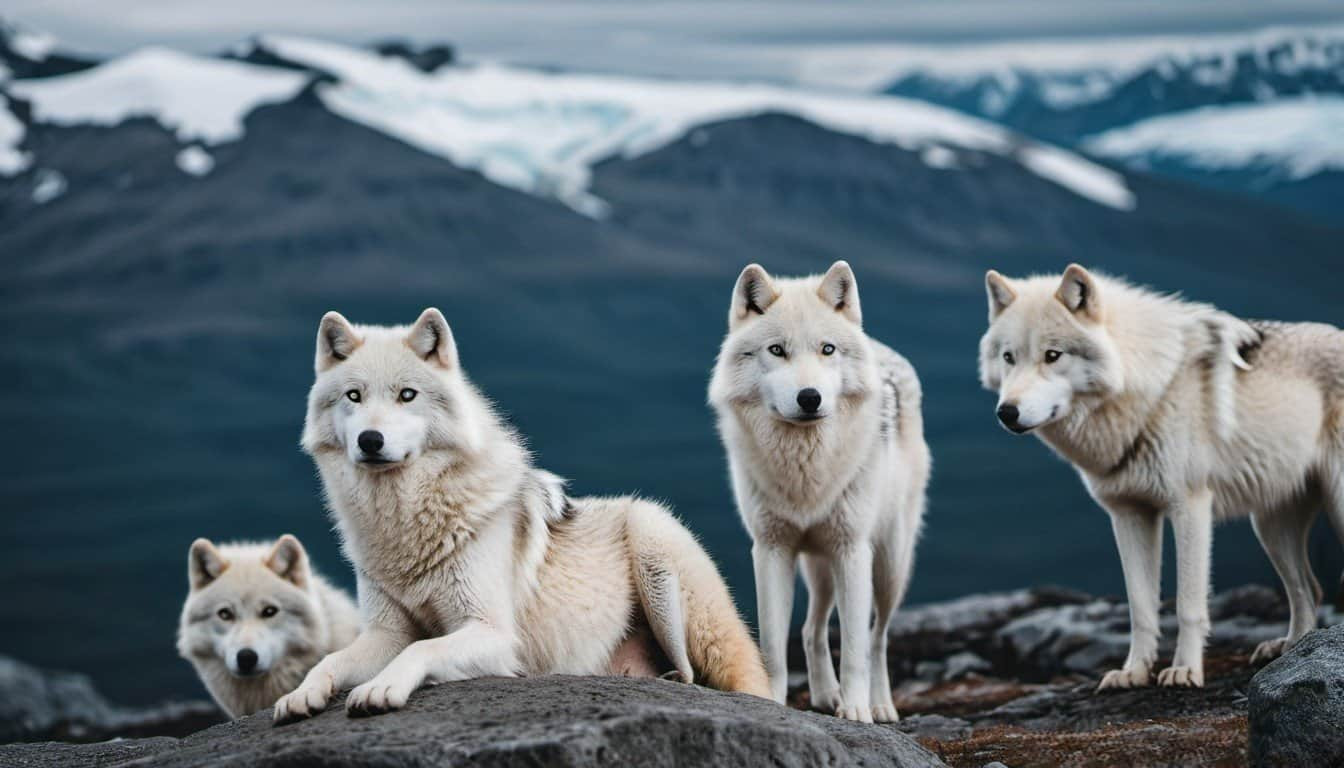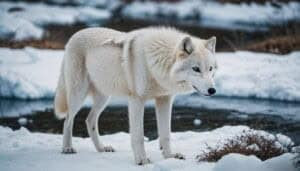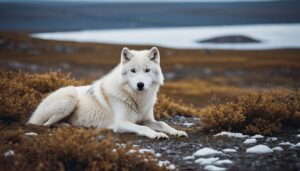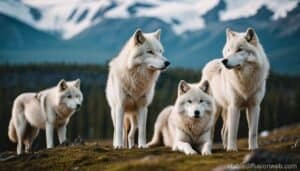Introduction
Arctic wolves, a unique and resilient species, primarily inhabit the cold and remote regions of the Arctic. This article explores the specific areas where these wolves thrive, the harsh environmental conditions they endure, and their remarkable adaptations
Additionally, we will delve into their migration patterns, population distribution, the impact of human activities on their habitats, and ongoing conservation efforts to protect these magnificent creatures
Arctic Territories and Countries
Arctic wolves inhabit some of the most extreme environments on Earth. The Arctic region spans several countries, each offering unique habitats for these resilient animals
Understanding the specific territories within these countries helps provide a clearer picture of where Arctic wolves predominantly live
Canada
Canada is home to vast stretches of Arctic tundra, particularly in its northern territories such as Nunavut, Northwest Territories, and Yukon. The Canadian Arctic Archipelago, with its numerous islands, provides a varied landscape where Arctic wolves thrive
These regions are characterized by their remote, icy terrains, which are ideal for the wolves’ hunting and living conditions
Greenland
Greenland, an autonomous territory within the Kingdom of Denmark, is another crucial habitat for Arctic wolves. The island’s rugged and icy landscapes offer an environment where these wolves can hunt and roam freely
The northeastern part of Greenland, in particular, has a significant population of Arctic wolves, benefiting from the remote and undisturbed nature of the area
Russia
Russia’s vast Arctic region, encompassing areas such as Siberia and the Far East, provides a significant portion of the habitat for Arctic wolves
The extensive tundra and taiga regions, along with coastal areas along the Arctic Ocean, create diverse environments for these wolves. The Chukotka and Yamalo-Nenets regions are especially notable for their wolf populations
United States (Alaska)
Alaska, the northernmost state of the United States, contains extensive Arctic territories where Arctic wolves are found. The North Slope, a large, sparsely populated area stretching from the Brooks Range to the Arctic Ocean, is a primary habitat
The region’s harsh climate and remote wilderness provide ideal conditions for the wolves’ survival and hunting activities
Arctic Environment and Living Conditions
Arctic wolves are uniquely adapted to survive in one of the most challenging environments on the planet. The Arctic environment, characterized by extreme cold, extensive ice and snow cover, and limited vegetation, shapes the living conditions and behaviors of these wolves
Extreme Cold
The Arctic is known for its frigid temperatures, often plunging well below freezing. Arctic wolves have several adaptations to cope with the cold, such as thick fur, a dense undercoat, and a compact body shape that minimizes heat loss
These physical traits allow them to endure and thrive in temperatures that would be inhospitable to many other species
Ice and Snow Cover
Ice and snow dominate the Arctic landscape for most of the year, influencing the wolves’ hunting and movement patterns. Arctic wolves are skilled at navigating icy terrains and can travel long distances across snow-covered landscapes in search of food
Their large, padded paws provide traction on slippery surfaces, aiding their mobility
Limited Vegetation
Vegetation in the Arctic is sparse, limited to hardy plants that can survive the short growing season
This scarcity of plant life means that Arctic wolves primarily rely on a diet of meat, hunting animals such as musk oxen, Arctic hares, and lemmings. The limited vegetation also impacts the availability of prey, making the wolves’ hunting skills and adaptability crucial for their survival
Adaptations and Survival
Arctic wolves possess remarkable adaptations that enable them to survive and thrive in the harsh Arctic environment. These adaptations include both physical and behavioral traits that have evolved over time to help them cope with extreme cold, scarce food sources, and long periods of darkness
Physical Adaptations
Arctic wolves have several physical adaptations that are essential for surviving the extreme conditions of the Arctic:
Thick Fur: Their thick, double-layered coat provides insulation against the cold. The outer layer of fur repels water and snow, while the dense undercoat traps heat close to the body
Compact Body Shape: Their bodies are more compact compared to other wolf species, which helps minimize heat loss. Shorter ears and muzzles reduce the surface area exposed to the cold, conserving body heat
Large Paws: The wolves have large, padded paws that act like snowshoes, distributing their weight more evenly on snow and ice. This adaptation not only aids in mobility but also prevents sinking into the snow
Seasonal Fur Color: Their fur changes color with the seasons, blending into the snowy landscape in winter and the tundra in summer. This camouflage helps them avoid detection by both prey and predators
Behavioral Adaptations
Behavioral adaptations also play a crucial role in the Arctic wolves’ survival, allowing them to efficiently hunt, conserve energy, and protect themselves from the elements:
Pack Hunting: Arctic wolves hunt in packs, which increases their success rate in capturing large prey such as musk oxen and caribou. Pack hunting also allows them to tackle prey that is too large for a single wolf
Denning: To protect themselves from the cold, Arctic wolves dig dens in the ground or use existing caves and rock formations. These dens provide shelter from harsh weather and a safe place for raising pups
Seasonal Movements: During the harshest winter months, when food is scarce, Arctic wolves may move to areas with higher prey density. This seasonal movement helps them find sufficient food to survive
Social Structure: The pack’s social structure, with a clear hierarchy and cooperation among members, ensures efficient hunting and protection. The alpha pair leads the pack, making crucial decisions for the group’s survival
These adaptations highlight the Arctic wolves’ resilience and ability to thrive in one of the world’s most unforgiving environments
Habitation and Migration Patterns
Arctic wolves have distinct habitation and migration patterns that are influenced by the seasonal changes and availability of prey within the Arctic region. Understanding these patterns provides insight into their survival strategies and adaptability in the extreme Arctic environment
Tundra Regions
Arctic wolves are commonly found in the tundra regions of the Arctic. The tundra is characterized by its vast, treeless plains, which are covered in snow for most of the year
These regions offer a relatively flat terrain, making it easier for wolves to travel and hunt. The tundra also supports a variety of prey species such as caribou and lemmings, which are crucial for the wolves’ diet
Coastal Areas
Coastal areas along the Arctic Ocean provide another vital habitat for Arctic wolves. These regions often have a higher density of prey due to the presence of marine mammals and birds
Coastal areas can also offer more moderate temperatures and slightly more diverse vegetation compared to the interior tundra. Wolves in these areas may feed on seals, seabirds, and fish, especially when other prey is scarce
Mountainous Areas
In some parts of the Arctic, mountainous areas offer unique habitats for Arctic wolves. These regions provide rugged terrain with numerous hiding spots and vantage points for hunting
The diverse landscape can support different prey species and offer shelter from extreme weather conditions. Wolves in mountainous areas may adapt their hunting techniques to navigate the challenging terrain and catch agile prey like mountain goats
Seasonal Migration
Arctic wolves exhibit seasonal migration patterns to cope with the extreme environmental changes throughout the year. During the winter, when food is scarce, wolves may migrate to areas with higher prey density
These migrations can cover vast distances, showcasing the wolves’ endurance and adaptability. In the summer, when prey is more abundant, they may return to their traditional hunting grounds
Long-distance Travel
Long-distance travel is a common behavior for Arctic wolves, allowing them to exploit different habitats and follow migrating prey. These journeys can span hundreds of miles and are essential for their survival in the harsh Arctic environment
The ability to travel long distances helps them locate food, find mates, and avoid harsh weather conditions
Population and Distribution
Arctic wolves have a population distribution that varies across different regions of the Arctic. Several factors influence their population density and distribution, including prey availability, environmental conditions, and human activities
Density in Different Regions
The population density of Arctic wolves can vary significantly across the Arctic. Regions with abundant prey and favorable environmental conditions tend to have higher wolf densities
For example, areas with large caribou herds or extensive coastal food resources may support more wolves. Conversely, regions with harsh climates and scarce food sources may have lower wolf densities
Factors Influencing Distribution
Several factors influence the distribution of Arctic wolves, including:
Prey Availability: The abundance and distribution of prey species are critical determinants of wolf populations. Wolves are more likely to inhabit areas with reliable food sources
Climate and Weather: Extreme weather conditions and seasonal changes impact the wolves’ ability to hunt and survive. Regions with milder climates and stable weather may support more consistent wolf populations
Human Activities: Human activities, such as hunting, industrial development, and climate change, can affect wolf distribution. Areas with minimal human disturbance are more likely to support stable wolf populations
Understanding these factors is essential for conservation efforts aimed at protecting Arctic wolves and their habitats
Seasonal and Human Impact on Habitat
The Arctic environment undergoes dramatic seasonal changes that significantly affect the habitats of Arctic wolves. Additionally, human activities in the region have increasingly influenced the availability and quality of these habitats
Understanding these impacts is crucial for the conservation of Arctic wolves
Winter Conditions
Winter in the Arctic is marked by extreme cold, long periods of darkness, and heavy snowfall. These conditions profoundly impact the behavior and survival strategies of Arctic wolves:
Hunting Challenges: Deep snow can make it difficult for wolves to move and hunt efficiently. However, their large, padded paws help them travel across the snow without sinking. The scarcity of prey during winter forces wolves to cover larger territories in search of food
Shelter: To protect themselves from the severe cold, Arctic wolves often seek shelter in dens or caves. These shelters provide a refuge from the elements and a safe place to raise their pups. The availability of suitable den sites is crucial for their survival during winter
Energy Conservation: Wolves need to conserve energy to survive the harsh winter. They reduce their activity levels and rely on fat reserves built up during the summer and fall. Pack behavior also plays a vital role, as hunting in groups can increase their success rate and reduce individual energy expenditure
Summer Changes
The summer season brings a brief period of relative abundance and milder weather to the Arctic. These changes affect the habitat and behavior of Arctic wolves:
Increased Prey Availability: Summer sees a surge in prey species, including caribou, musk oxen, and Arctic hares. The melting snow and ice reveal vegetation, attracting herbivores and, in turn, providing ample hunting opportunities for wolves
Raising Pups: The summer months are critical for raising pups. The abundance of food allows adult wolves to provide for their young, ensuring they grow strong enough to survive the coming winter. Pups learn essential hunting and survival skills during this period
Territorial Behavior: With the increase in prey, wolves become more territorial, defending their hunting grounds from other packs. This behavior ensures they have sufficient resources to sustain their pack
Climate Change
Climate change poses a significant threat to the habitats of Arctic wolves. Rising temperatures and changing weather patterns disrupt the delicate balance of the Arctic ecosystem:
Shrinking Ice: The melting of sea ice reduces the availability of coastal habitats and affects the distribution of prey species. Wolves that rely on ice-covered areas for hunting may find their food sources diminished
Altered Prey Migration: Climate change can alter the migration patterns of prey species, making it more difficult for wolves to predict and follow their movements. This unpredictability can lead to food shortages and increased competition among wolves
Habitat Loss: Thawing permafrost and changing vegetation patterns can lead to habitat loss, forcing wolves to adapt to new environments or face population declines. The loss of suitable denning sites further complicates their ability to raise pups
Industrial Activities
Human industrial activities in the Arctic, such as oil and gas exploration, mining, and infrastructure development, have direct and indirect impacts on Arctic wolves:
Habitat Fragmentation: Roads, pipelines, and other infrastructure projects can fragment wolf habitats, restricting their movement and access to prey. Fragmentation also increases the risk of human-wolf conflicts
Pollution: Industrial activities often lead to pollution, which can contaminate water sources and affect the health of wolves and their prey. Pollutants can also disrupt the natural balance of the ecosystem
Disturbance: Increased human presence and noise from industrial operations can disturb wolves and drive them away from critical habitats. This disturbance can lead to stress and negatively impact their reproductive success
Efforts to mitigate the impact of climate change and industrial activities are essential for the conservation of Arctic wolves and their habitats
Prey Species and Conservation
Arctic wolves rely on a variety of prey species for survival, and the conservation of these wolves involves understanding and protecting their food sources and habitats. Efforts to ensure the sustainability of these species are vital for maintaining healthy wolf populations in the Arctic
Musk Oxen
Musk oxen are a primary prey species for Arctic wolves, especially during the winter months when other food sources are scarce. These large herbivores are well-adapted to the harsh Arctic conditions and form an essential part of the wolves’ diet:
Hunting Techniques: Wolves often hunt musk oxen by isolating young, old, or weak individuals from the herd. They use pack strategies to outmaneuver and exhaust their prey, leveraging their cooperative hunting skills
Nutritional Value: Musk oxen provide a substantial amount of meat, which is crucial for the wolves’ energy needs, especially in winter. A successful hunt can sustain a wolf pack for several days
Population Dynamics: The population health of musk oxen directly affects the availability of food for Arctic wolves. Conservation efforts that support musk oxen populations are beneficial for maintaining stable wolf populations
Arctic Hares
Arctic hares are another significant prey species for Arctic wolves. These small mammals are abundant in the tundra regions and provide a reliable food source, particularly during the summer months:
Hunting Behavior: Wolves typically hunt Arctic hares individually or in small groups, relying on their speed and agility to catch these quick and nimble prey. The hares’ burrowing habits and tendency to stay in open areas make them accessible targets
Dietary Importance: Arctic hares are a vital part of the wolves’ diet, especially when larger prey like musk oxen are not available. They provide essential nutrients and help sustain the wolves through the year
Seasonal Availability: The abundance of Arctic hares can fluctuate with seasonal changes and environmental conditions. Wolves adapt their hunting strategies based on the availability of hares, highlighting the importance of this prey species
Lemmings
Lemmings, small rodents found throughout the Arctic tundra, are a crucial prey species for Arctic wolves, particularly during periods when other prey are less available:
Hunting Strategy: Wolves hunt lemmings primarily through stalking and pouncing. These small rodents are prolific breeders, and their population cycles can lead to periods of high abundance, providing a temporary but significant food source
Ecological Role: Lemmings play a critical role in the Arctic food web, supporting not only wolves but also a variety of other predators. Their population cycles influence the dynamics of the entire ecosystem
Impact of Climate Change: Changes in climate and vegetation can affect lemming populations, which in turn impacts the food availability for Arctic wolves. Monitoring lemming populations is essential for understanding the broader ecological health of the Arctic
Protected Areas
Establishing protected areas is a key strategy for conserving Arctic wolves and their habitats. These areas provide safe havens where wolves can live and hunt without the pressures of human encroachment and industrial activities:
Wildlife Reserves: Designated wildlife reserves and national parks in the Arctic help protect critical habitats for wolves and other wildlife. These areas restrict human activities and preserve the natural environment
Legal Protections: Implementing and enforcing legal protections for Arctic wolves and their habitats is crucial. Laws that regulate hunting, land use, and industrial activities help mitigate human impacts and support conservation efforts
Community Involvement: Involving local communities in conservation initiatives fosters a collaborative approach to protecting Arctic wolves. Indigenous knowledge and practices can enhance conservation strategies and ensure sustainable coexistence
Research and Monitoring Programs
Ongoing research and monitoring are vital for understanding the status and health of Arctic wolf populations and their ecosystems. These programs provide data that inform conservation actions and policies:
Population Surveys: Regular surveys and tracking of wolf populations help assess their numbers, distribution, and health. This information is critical for making informed conservation decisions
Ecological Studies: Studying the relationships between Arctic wolves, their prey, and the environment provides insights into the complex dynamics of the Arctic ecosystem. Ecological research helps identify key factors influencing wolf populations
Climate Impact Research: Investigating the effects of climate change on Arctic wolves and their habitats helps predict future challenges and develop adaptive conservation strategies. Research on changing prey populations, habitat shifts, and other climate-related factors is essential for long-term conservation planning
Conclusion
Arctic wolves are extraordinary animals that have adapted to some of the most extreme conditions on Earth. Their habitats span various regions of the Arctic, including tundra, coastal, and mountainous areas across countries such as Canada, Greenland, Russia, and the United States (Alaska). These regions offer the unique environments necessary for the wolves to hunt, migrate, and thrive
The harsh Arctic environment, characterized by extreme cold, ice, snow, and limited vegetation, presents significant challenges for survival. Arctic wolves have developed remarkable physical and behavioral adaptations to cope with these conditions, including thick fur, large paws, pack hunting strategies, and seasonal migrations
Understanding the distribution and population dynamics of Arctic wolves is essential for their conservation. Their habitats are influenced by factors such as prey availability, climate conditions, and human activities
Seasonal changes and human impacts, including climate change and industrial development, pose significant threats to their survival
Arctic wolves rely on various prey species, including musk oxen, Arctic hares, and lemmings. Conservation efforts must focus on protecting these prey populations and their habitats. Establishing protected areas, implementing legal protections, and involving local communities are crucial steps in safeguarding Arctic wolves
Ongoing research and monitoring programs play a vital role in understanding and conserving Arctic wolves. These programs provide valuable data on wolf populations, ecological relationships, and the impacts of climate change
By continuing to study and protect these magnificent animals, we can ensure their survival in the rapidly changing Arctic environment










